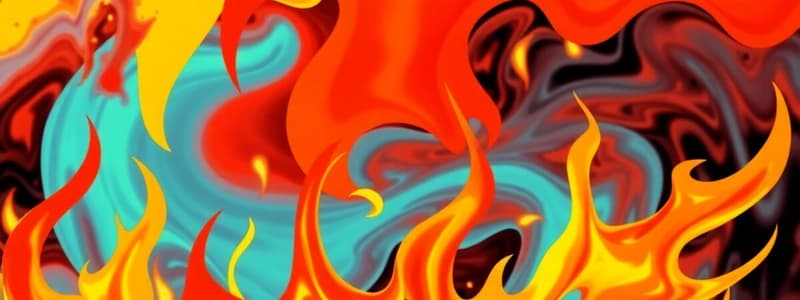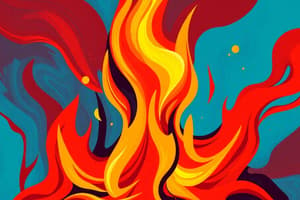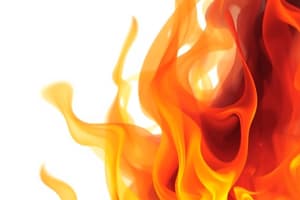Podcast
Questions and Answers
What fundamental process is fire characterized by?
What fundamental process is fire characterized by?
- The conversion of matter from solid to liquid.
- A chemical reaction that absorbs heat.
- Rapid oxidation of a flammable material. (correct)
- Slow decomposition of organic matter.
Besides heat and light, what other significant benefit has the discovery of fire provided to societies?
Besides heat and light, what other significant benefit has the discovery of fire provided to societies?
- Source of clean drinking water.
- Advancements in agriculture.
- Advancements to people and industries. (correct)
- Improved construction techniques.
In the fire triangle, which element sustains the combustion process by reacting with fuel?
In the fire triangle, which element sustains the combustion process by reacting with fuel?
- Fuel
- Oxygen (correct)
- Nitrogen
- Heat
Why is it essential to keep flammable materials away from heat sources?
Why is it essential to keep flammable materials away from heat sources?
What immediate action should you take if an electrical appliance malfunctions and poses a fire risk?
What immediate action should you take if an electrical appliance malfunctions and poses a fire risk?
According to the fire safety guidelines, why should electrical wiring be checked regularly?
According to the fire safety guidelines, why should electrical wiring be checked regularly?
Which of the following scenarios is an example of neglecting fire safety precautions?
Which of the following scenarios is an example of neglecting fire safety precautions?
Why is it essential to educate both children and adults about fire safety?
Why is it essential to educate both children and adults about fire safety?
What is the primary reason for labeling flammable materials properly?
What is the primary reason for labeling flammable materials properly?
In the event of a small kitchen fire, which of these is an appropriate first response?
In the event of a small kitchen fire, which of these is an appropriate first response?
What is the first step to take when using a fire extinguisher, according to the TPASS method?
What is the first step to take when using a fire extinguisher, according to the TPASS method?
Why is it important to install fire alarms and smoke detectors in a building?
Why is it important to install fire alarms and smoke detectors in a building?
What is the recommended action to take after sounding an alarm during a fire?
What is the recommended action to take after sounding an alarm during a fire?
Which of the following is the most crucial reason for participating in fire drills?
Which of the following is the most crucial reason for participating in fire drills?
According to the guidelines, what should you do immediately if a fire is too large to control?
According to the guidelines, what should you do immediately if a fire is too large to control?
What is the primary reason to 'yield' to firefighters or responders at the scene of a fire?
What is the primary reason to 'yield' to firefighters or responders at the scene of a fire?
What is the main goal of developing a fire preparation plan?
What is the main goal of developing a fire preparation plan?
What does the 'A' stand for in the SAFETY acronym ('Sound any available alarm, Alert the nearest fire station/brigade, Fight the fire while it is still small, Evacuate immediately if the fire gets out of control, Tell others about fire, Yield to firefighters, responders, or rescuers')?
What does the 'A' stand for in the SAFETY acronym ('Sound any available alarm, Alert the nearest fire station/brigade, Fight the fire while it is still small, Evacuate immediately if the fire gets out of control, Tell others about fire, Yield to firefighters, responders, or rescuers')?
According to fire safety measures, why should a wet cloth or accessible water source always be available when flammable materials are in use?
According to fire safety measures, why should a wet cloth or accessible water source always be available when flammable materials are in use?
Which of the following is a direct contradiction of fire safety precautions?
Which of the following is a direct contradiction of fire safety precautions?
Flashcards
What is Fire?
What is Fire?
Rapid oxidation of flammable material producing light and heat.
What is Fuel?
What is Fuel?
Combustible substances in any state (solid, liquid, gas).
What is Heat?
What is Heat?
Energy that raises fuel temperature to ignition point.
What is Oxygen's role in fire?
What is Oxygen's role in fire?
Signup and view all the flashcards
Common Causes of Fire
Common Causes of Fire
Signup and view all the flashcards
Fire Safety Measures
Fire Safety Measures
Signup and view all the flashcards
Fire Extinguisher Use (TPASS)
Fire Extinguisher Use (TPASS)
Signup and view all the flashcards
Fire Extinguisher Use (in filipino)
Fire Extinguisher Use (in filipino)
Signup and view all the flashcards
SAFETY: Fire Response Steps
SAFETY: Fire Response Steps
Signup and view all the flashcards
Purpose of Fire Alarms
Purpose of Fire Alarms
Signup and view all the flashcards
Study Notes
- Fire involves rapid oxidation of flammable material, producing light and heat.
- The discovery of fire led to advancements for people and industries by providing heat, light, and power.
Elements of Fire
- Fuel, heat, and oxygen are the three elements needed for fire.
- Fire will not happen if one of these elements is missing.
Fuel
- Fuels are combustible materials and can be solid, liquid, or gas.
Heat
- Heat raises the temperature of the fuel to its ignition point.
Oxygen
- Oxygen supports the combustion process to sustain burning.
Common Causes of Fire
- Faulty electrical wiring or connections
- Issues related to LPG (Liquefied Petroleum Gas)
- Neglected cooking or stoves
- Unattended open flames from torches, candles, or gas lamps
- Matchsticks or lighters left near flammable materials
- Lighted cigarette butts
- Neglected electrical appliances or devices
- Unchecked electrical machinery
- Flammable chemicals like gasoline, acetone, and butane
- Spontaneous combustion
- Bomb explosions
- Lightning
- Other causes such as forest fires or vehicular fires
Fire Safety Measures
- Never leave a fire unattended, whether it's a stovetop, candle, or bonfire; always extinguish it before leaving
- Regularly check electrical equipment and wiring for malfunctions or overloading
- Keep flammable materials away from ignition sources and maintain a clutter-free environment
- Educate children and adults about fire safety, including prevention and proper handling of flammable substances
- Store flammable materials properly, labeled, away from heat sources, and clean up any spills immediately.
- Keep a fire extinguisher readily accessible, along with a wet cloth or water source
How to Use a Fire Extinguisher (TPASS)
- T- Twist pin to remove seal
- P - Pull the pin
- A - Aim the nozzle
- S - Squeeze the lever
- Sweep the base of the fire side to side
Fire Extinguisher Use Acronym (HTPP)
- H - Hugot (Pull the Pin)
- T - Tutok (Aim the Nozzle)
- P - Putok (Squeeze the Lever)
- P - Pagpag (Sweep Side to Side)
Fire Safety Systems
- Install fire alarms and smoke detectors to provide early warning
- Participate in fire drills and know the exit points of buildings
- Educate yourself and others on fire safety and emergency procedures
What to Do in Case of Fire
- Sound the alarm
- Alert the fire department
- Fight the fire if it is still small
- Evacuate immediately if the fire is out of control
- Tell others about the fire
- Yield to firefighters and emergency responders
- Develop a fire preparation plan
Studying That Suits You
Use AI to generate personalized quizzes and flashcards to suit your learning preferences.




